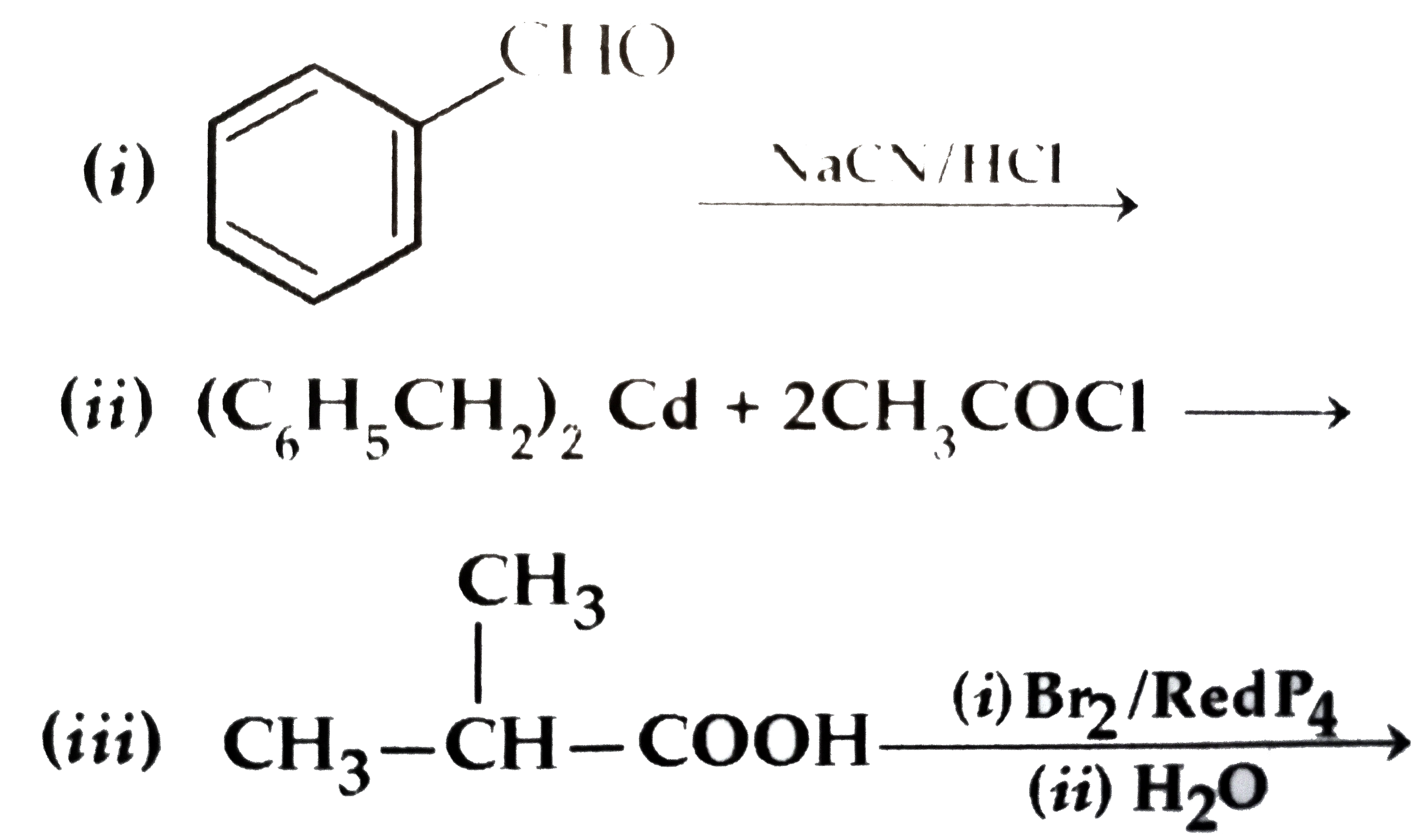Complete the following :
(ii) CH3CONH2+NaOH+Br2→
To complete the reaction of acetamide (CH₃CONH₂) with sodium hydroxide (NaOH) and bromine (Br₂), we will follow the mechanism step by step.
1. Identify the Reactants:
The reactants are acetamide (CH₃CONH₂), sodium hydroxide (NaOH), and bromine (Br₂).
2. Deprotonation of Acetamide:
Sodium hydroxide (a strong base) will deprotonate the amide group of acetamide. This results in the formation of the acetamide anion:
CH3CONH2+NaOH→CH3CONH−+H2O
3. Bromination:
The acetamide anion can now react with bromine (Br₂). The bromine will substitute one of the hydrogen atoms on the nitrogen, forming N-bromoacetamide:
CH3CONH−+Br2→CH3CONHBr+Br−
4. Second Deprotonation:
The base (NaOH) can again deprotonate the N-bromoacetamide, leading to the formation of a more reactive intermediate:
CH3CONHBr+NaOH→CH3CONH−+H2O+Br−
5. Formation of Isocyanate:
The N-bromoacetamide undergoes a rearrangement to form isocyanate (a reactive intermediate):
CH3CONH−→CH3NCO
6. Hydrolysis of Isocyanate:
The isocyanate can then react with water to form carbamic acid:
CH3NCO+H2O→CH3NHCOOH
7. Decarboxylation:
Carbamic acid is unstable and will undergo decarboxylation to yield a primary amine (methylamine) and carbon dioxide:
CH3NHCOOH→CH3NH2+CO2
Final Products:
The final products of the reaction are:
- Methylamine (CH₃NH₂)
- Carbon dioxide (CO₂)
Summary of the Reaction:
CH3CONH2+NaOH+Br2→CH3NH2+CO2
---
The reactants are acetamide (CH₃CONH₂), sodium hydroxide (NaOH), and bromine (Br₂).
Sodium hydroxide (a strong base) will deprotonate the amide group of acetamide. This results in the formation of the acetamide anion:
CH3CONH2+NaOH→CH3CONH−+H2O
The acetamide anion can now react with bromine (Br₂). The bromine will substitute one of the hydrogen atoms on the nitrogen, forming N-bromoacetamide:
CH3CONH−+Br2→CH3CONHBr+Br−
The base (NaOH) can again deprotonate the N-bromoacetamide, leading to the formation of a more reactive intermediate:
CH3CONHBr+NaOH→CH3CONH−+H2O+Br−
The N-bromoacetamide undergoes a rearrangement to form isocyanate (a reactive intermediate):
CH3CONH−→CH3NCO
The isocyanate can then react with water to form carbamic acid:
CH3NCO+H2O→CH3NHCOOH
Carbamic acid is unstable and will undergo decarboxylation to yield a primary amine (methylamine) and carbon dioxide:
CH3NHCOOH→CH3NH2+CO2
The final products of the reaction are:
- Methylamine (CH₃NH₂)
- Carbon dioxide (CO₂)
CH3CONH2+NaOH+Br2→CH3NH2+CO2
Topper's Solved these Questions
- ALDEHYDES,KETONES AND CARBOXYLIC ACIDSBook:CBSE COMPLEMENTARY MATERIALChapter:ALDEHYDES,KETONES AND CARBOXYLIC ACIDSExercise:LONG ANSWER TYPE QUESTIONS (5 MARKS)
Explore 21 Videos
- ALDEHYDES,KETONES AND CARBOXYLIC ACIDSBook:CBSE COMPLEMENTARY MATERIALChapter:ALDEHYDES,KETONES AND CARBOXYLIC ACIDSExercise:SHORT ANSWER -I TYPE QUESTIONS (2 MARKS)
Explore 30 Videos
- ALCOHOLS, PHENOLS AND ETHERSBook:CBSE COMPLEMENTARY MATERIALChapter:ALCOHOLS, PHENOLS AND ETHERSExercise:LONG ANSWER TYPE QUESTIONS (5 Marks)
Explore 5 Videos
- AMINESBook:CBSE COMPLEMENTARY MATERIALChapter:AMINESExercise:5 MARKS
Explore 7 Videos
Similar Questions
Knowledge Check
Consider the following reaction
CH3−CONH2I−−→CH3−NH2II−−→CH3NCAReaction I is called Hofmann's amine reactionBReaction II is called carbyl amine reactionCReaction I and II are Hofmann reactionsDBoth 'a' and 'b' are correct statements.Which of the following converts CH3CONH2 to CH3NH2 ?
ANaBrBNaOBrCBr2DNone of these
Complete the following reactions:
(i)
(ii) (C6H5CH2)2Cd+2CH3COC<o
(iii) CH3−CH3∣CH−COOH(i)Br2/RedP4−−−−−−−−−→(ii)H2O
View SolutionComplete the following
(i). CH3COOAg+Br2CCl4−−−→Reflux
View SolutionComplete the following chemical equations :
(i) CH3COOC2H5+NaOH→
(ii) CH3COOH+NaOH→
(iii) C2H5OH+CH3COOHConc. H2SO4−−−−−−−−→
View SolutionComplete the following reactions :
CH3CH2BrAlc.KOH−−−−−→
View SolutionCH3COOHNaOH−−−→[A]NaOH−−−→CaO[B]Br2−−→hv[C]
View SolutionComplete the following by suppling intermediates
CH3COOHNaOH−−−→ANaOH,Cao−−−−−−−−→630KBBr2−−−−−→hvC
View Solution
